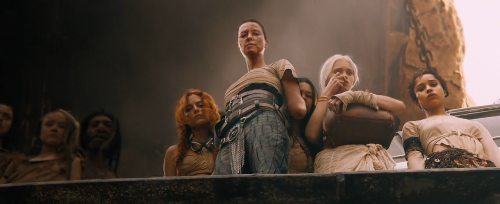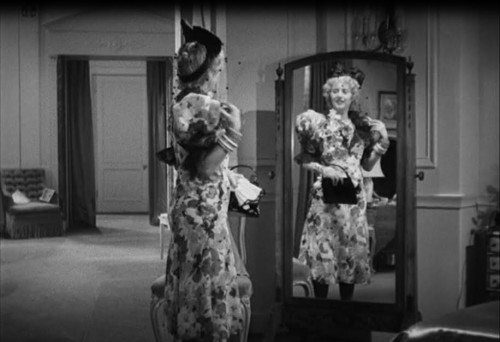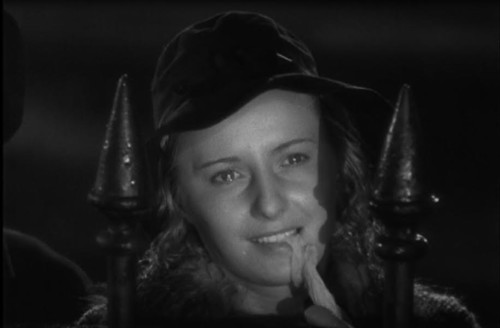Mad Max: Fury Road‘s Imperator Furiosa and the five wives look down upon the Citadel
This guest post by Cate Young appears as part of our theme week on Violent Women.
It’s a phrase we hear over and over in pop culture, usually in reference to a female character in an action movie who has lots of guns. “Strong female characters” know how to fight, know how to use weapons and they best all the boys in confrontation. “Strong Female Characters” are effectively measured by their capacity for violence and their competence in the theatre of war.
But what does it mean when we equate strength with violence on a cultural level, and especially in relation to women’s place in society?
In Mad Max: Fury Road the “strong female characters” are notable specifically for their aversion to violence. The film portrays its women as emotionally strong people who engage in violence only in self-defense, and only against the system that oppresses them.
The film is set in a post-apocalyptic future desert wasteland where women have been reduced to various forms of slavery and their value is determined by what their bodies can produce. Whether it be breastmilk or babies, women’s position in this world is determined by their physical utility to the oppressive system they occupy. Furiosa is the notable exception, an Imperator who has presumably worked her way up the ranks of Immortan Joe’s highly patriarchal and hyper-masculine cultish new social order.
From the very beginning of the film we see how the women of this world conspicuously and determinedly avoid violence. We are introduced to the Five Wives initially through their absence; they have run away with Imperator Furiosa leaving behind a message for their captor Immortan Joe.
“Our Babies Will Not Be Warlords.” The Five Wives not only want to opt out of the violent system but also ensure that the system does not continue
These simple messages convey two main points: that the Wives are aware of their entitlement to freedom due to their inherent human dignity, and that they acknowledge that eliminating violence not only starts with them, but extends into preventing violence in the next generation. Their first act of resistance is a direct hit against the very violence that allows the oppressive system of this world to maintain itself; removing their future children from the violence of Immortan’s world.
“We Are Not Things.” Miss Giddy defends the Wives’ right to freedom
Later in the film, we see the Wives sidestep violence once again when the War Boy Nux attacks Furiosa as she is driving the War Rig. Furiosa initially wants to kill Nux, but the Wives tell her that there will be “no unnecessary killing” as Nux is brainwashed and “kamakrazee.” Essentially, the Wives know that even though Nux seeks to do them harm, he is simply a product of a violently oppressive system that positions violence as the way to salvation in Valhalla. He is a natural result of this system and a reflection of the fate they are trying to avoid for their own children, and they elect to toss him out of the Rig instead.
This conscious avoidance of violence is replicated in what I think is one of the most powerful scenes in the film: Splendid the Angharad, heavily pregnant with Immortan’s child, uses her body as a shield to protect Furiosa from Immortan’s bullets.
Splendid the Angharad as anti-patriarchal human shield
As I wrote in my initial review of the film:
She literally uses her body, the site of which has undoubtedly been home to rape and assault at the hands of Immortan Joe, (and now a constant reminder of such) as a weapon against him. She uses her increased patriarchal “value” against the very man who rules the patriarchal system of their world. To me, that was a powerful scene because it showed that even as her body had been used against her will to perpetuate a system that enslaved her, The Splendid Angharad did not view herself as property, but as an equal human being, capable of more than breeding warlords. Furiosa’s escape with the Wives was not so much a rescue as a partnership. She and the Wives worked together to achieve shared liberation in The Green Place.
The scene was a clever subversion of the hyper-violence of the film. Angharad’s body, a site of much violence, is used to prevent more of the same, as the other Wives cling to her to keep her safe. It shows that the Wives understand their relative position in this society, the role that ritual violence plays, and their ability to use it to their advantage.
Soon after this scene, Angharad dies, having fallen from the Rig. Furiosa and the Wives are devastated but know they must press-on. After Furiosa asks Toast The Knowing to the match their remaining bullets with their corresponding guns and she informs her that they have very little ammunition left, Dag and Cheedo note that Angharad used to call the bullets “anti-seed”:
“Plant one and watch something die.”
This relates thematically to the violence done upon the very earth on which they live by the men of the world. With reliance on guns and ammunition, the men have “killed the world” and now nothing grows. The state of the earth mirrors the violence that is done to the women and their bodies. It is fitting then that the women who are seeking salvation in “The Green Place” (that they later discover is barren) and are kept by Immortan as “breeders” due to the world’s low fertility would have very little “anti-seed” available to them.
The green place of Furiosa’s youth is now a barren swamp wasteland
When we are finally introduced to the Vuvalini, Furiosa’s previous clan of “Many Mothers” we discover that The Green Place has been decimated and that they are the last members of the clan to survive. These women however, many of them in their senior years are hardened to the world and perfectly acknowledge and understand that violence is sometimes necessary to achieve liberation.
The Vuvalini understand that violence is sometimes needed to achieve liberation
In confrontation with the War Boys and Immortan Joe during their journey back to the Citadel, the Vuvalini defend themselves and the Five Wives from attack on all fronts as the men descend upon them. While many of them fall, their bravery and willingness to sacrifice themselves in some ways mirrors the blind devotion that the War Boys show to Immortan Joe. The difference here is that they die in service to a liberatory ideal and not a cult of personality. The Vuvalini’s advanced age also serves to upturn our cultural notions of what strength entails. Even in the problematic context of strong women as violent, this rarely if ever includes the old. By being portrayed as capable and willing even in their age, the film redefines strength to encompass women who do not usually fall under this umbrella. Even better, it affords the Vuvalini, (including the Keeper of Seeds, and therefore life, strength, youth and vitality) the courtesy of demonstrating that their strength runs deeper than physical violence.
Finally, in the very last act of violence that we see a woman commit in the film, Furiosa confronts Immortan Joe and rips his breathing apparatus away, killing him and removing large chunks of his face. As one of the only acts of violence that can conceivably be perceived as revenge, Furiosa not only kills Immortan, but physically removes his face and thereby his identity, much in the same way that his violence against the Five Wives removed theirs.
Furiosa denies Immortan his identity through violence
It’s fitting that not only does Furiosa kill Immortan, but in light of the desolation of The Green Place she remembers from her youth, she takes up residence with the Wives in the Citadel at the end of the film. She essentially seeks to invert the history of the centre of this world’s violence by making it the centre of redemption instead. With access to clean water and greenery, she can reestablish the environmental richness of her youth, not just for her, but for all of the oppressed citizens of Immortan’s regime.
The Milking Mothers once again provide sustenance to the citizens of Immortan’s oppressive regime
In the end, these “strong female characters” are allowed to avoid violence as much as possible, engaging only as a last resort, and still emerge victorious.
They are allowed to divorce strength from the violence that we assume is inherent to that characteristic, and in the process highlight many of the problems with this larger cultural assumption.



















